
|
xTuple ERP Reference Guide |
To add a new Return Authorization Line Item, select the NEW button. The following screen will appear:
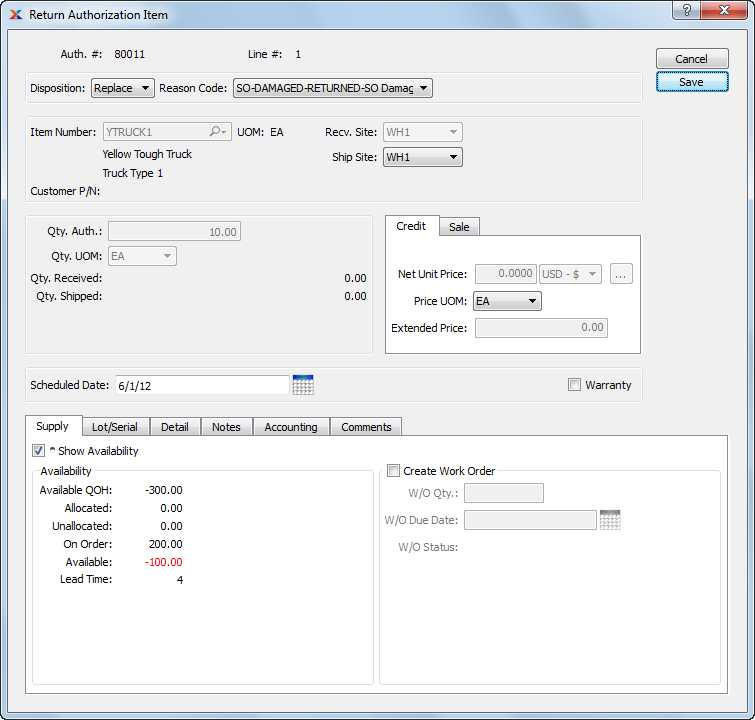
When creating a new Return Authorization Line Item, you are presented with the following options:
Displays the Return Authorization Number specified on the Return Authorization header.
Displays the Line Item Number for the current Line Item.
Displays the original Sales Order Number if the Line Item has been imported into the Return Authorization. Importing Return Authorization Line Items from an original Sales Order is optional only. When Line Items are imported, the original quantities and pricing information are imported also.
Displays the original Sales Order Line Item Number.
Displays the Order Number for the new Sales Order created in support of the Return Authorization, if applicable. New Sales Orders will be automatically created for Return Authorizations having the following dispositions: Replace, Service, Ship.
Displays the Line Item Number for the new Sales Order.
Line Item dispositions are defaulted conditionally based on the Return Authorization's header-level disposition setting. However, you may manually over-ride the line level disposition when creating or Return Authorization Line Items provided you do so before a quantity has been authorized. The following options are available:
Select to authorize the issuing of credit for the specified Item quantity at the specified Price. No return is required or expected.
Select to authorize the return of the specified Item quantity at the specified Price.
Select to authorize the replacement of the specified Item quantity.
Select to authorize the servicing of an Item for the specified quantity. This disposition is valid only for Job Items. Price controls will be disabled for this disposition. A new Sales Order with linked Work Order(s) will be created to track work and shipping on the repair or service. The billing for service or repair work should be handled on the new Sales Order. Service or repair items should first be received by the Return Authorization. If the Job Item is Lot/Serial controlled, you will be prompted to assign Lot/Serial numbers when the receipt is posted. This assignment of Lot/Serial Numbers can be simplified if you link authorized line items with existing Lot/Serial Numbers at the line item level. For more information, please see Section 4.1.1.1, “Return Authorization Item Lot/Serial”.
Select to authorize a shipment of a specified quantity on a new Sales Order. The Price controls will be disabled for this disposition. A new corresponding Sales Order and line will be created if one does not already exist. The billing should be handled on the new Sales Order. When there are line items on the Return Authorization having the disposition "Ship" and the timing is "Upon Receipt," then all the "Ship" disposition line items will be created on the new Sales Order at the same time—at the moment when the return is first received.
Specify the reason for the Return Authorization. Reason codes are used to explain why a Customer return is being authorized. The Line Item inherits the Reason Code from the header, but may be overridden at the line level.
Enter the Item Number of the Item you want to authorize. The Items you may select will vary depending on the Line Item disposition. For example, only Job Items may be selected for Line Items having the Service disposition. Once an Item Number is entered, the Inventory Unit of Measure and Item description will automatically appear.
If a returned Item is an Average-Cost Item, is linked to a Sales Order, and will result in an Inventory receipt, the Average Cost for the Item on the Sales Order will be pulled into the return Line Item as the default value. If there is no Sales Order to reference, the cost on the receipt will default to the Standard Cost for the Item. If the Item Site is Average Cost, the Unit Cost will actually be editable on the return Line Item, so you can manually or programmatically change the value to whatever makes sense for your business practice.
Displays the Customer Part Number (i.e., Item Alias) that corresponds to the Item Number entered in the Item Number field. The Customer Part Number will display only if you enter an Item Alias in the Item Number field―or if an Alias was used on the original Sales Order. To enter an Item Alias, place the cursor in the Item Number field and then use the keyboard shortcut "CTRL + A". After you have entered a valid Item Alias, hit the TAB key. A list of Items that use the specified Item Alias will be displayed. Select the desired Item from the list. The Item Alias will display as the Customer Part Number. Item Aliases are defined on the Item master.
Specify the Site where you want the returned Item quantity to be received.
Specify the Site where you want authorized Return Authorization quantity to be shipped from. This option is only available for Line Items having a disposition which requires creation of a new Sales Order (i.e., Replace, Service, Ship).
Enter the quantity of the specified Item you want to authorize.
The quantity authorized is based on the quantity Unit of Measure.
Specify the Unit of Measure (UOM) to be used when selling the Line Item. Sold Items may be assigned multiple Selling UOMs. These alternate UOMs may be defined on the Item master. You may also select a global conversion ratio here. Global conversions have the label Global appended to them. If a Line Item has no Selling UOM defined, then the Inventory UOM will be used here by default.
Displays the Line Item quantity sold on the original Sales Order line if the Line Item was imported from an original Sales Order.
Displays the quantity received against the Return Authorization Line Item to date, if any.
Displays the Return Authorization Line Item quantity shipped to date, if any. This value applies to Line Items having a corresponding line on a new Sales Order.
If the Return Authorizations involves giving a Customer credit for the Line Item, then you may specify the following options:
Enter the amount of any restock charge discount, if any. This field is only displayed when the Return Authorization is being applied to an original Order.
Displays the Net Unit Price for the Sales Order Item. This information will be imported automatically for Return Authorizations linked to an original Sales Order if header disposition was Credit or Return when the order was imported. If there is no linked Sales Order, then the system will choose the lower of the following two Prices: A) The most-specific Pricing Schedule Assignment or B) any Sale in effect at the time of Order entry. The specificity of Pricing Schedule Assignments is determined in the following descending order: By Customer Ship-To Address (most specific), by Customer, by Customer Type, by Customer Type pattern, by all Customers. The lookup feature located to the right of the field leads to a Price List screen.
If your Pricing Schedule has multiple Units of Measure (UOM) on it (or if several Pricing Schedules share the same level of Price specificity, but they have different UOMs) then the UOM which matches the selected UOM will be chosen—that is, as long as the quantity break does not exceed the quantity being priced. If no entry matches the UOM with a quantity break less than the quantity being priced, then the lowest value Price for any UOM will be chosen. To make sure a specific UOM is always chosen at the desired level of Price specificity, then your Pricing Schedules should include at least one UOM with a quantity break of 0.
The Price controls will be automatically disabled for Line Items if a credit method has not been specified or for line items having the following dispositions: Service and Ship.
The Price Unit of Measure is the same as the Selling UOM. If an Item has Selling UOMs defined, then you will be able to select from between the Inventory UOM and any defined Selling UOMs. If no Selling UOMs have been defined, then the Inventory UOM will be used here by default.
Displays the Extended Price. The Extended Price for a Line Item is based on the quantity ordered multiplied by the Net Unit Price.
If the Return Authorizations involves re-selling the Line Item to the Customer, then you may specify the following options:
Enter the amount of any discount, if any.
Displays the Net Unit Price for the Sales Order Item. This information will be imported automatically for Return Authorizations linked to an original Sales Order if header disposition was Credit or Return when the order was imported. If there is no linked Sales Order, then the system will choose the lower of the following two Prices: A) The most-specific Pricing Schedule Assignment or B) any Sale in effect at the time of Order entry. The specificity of Pricing Schedule Assignments is determined in the following descending order: By Customer Ship-To Address (most specific), by Customer, by Customer Type, by Customer Type pattern, by all Customers. The lookup feature located to the right of the field leads to a Price List screen.
If your Pricing Schedule has multiple Units of Measure (UOM) on it—or if several Pricing Schedules share the same level of Price specificity, but they have different UOMs—then the UOM which matches the selected UOM will be chosen—that is, as long as the quantity break does not exceed the quantity being priced. If no entry matches the UOM with a quantity break less than the quantity being priced, then the lowest value Price for any UOM will be chosen. To make sure a specific UOM is always chosen at the desired level of Price specificity, then your Pricing Schedules should include at least one UOM with a quantity break of 0.
The Price controls will be automatically disabled for Line Items if a credit method has not been specified or for line items having the following dispositions: Service and Ship.
The Price Unit of Measure is the same as the Selling UOM. If an Item has Selling UOMs defined, then you will be able to select from between the Inventory UOM and any defined Selling UOMs. If no Selling UOMs have been defined, then the Inventory UOM will be used here by default.
Displays the Extended Price. The Extended Price for a Line Item is based on the quantity ordered multiplied by the Net Unit Price.
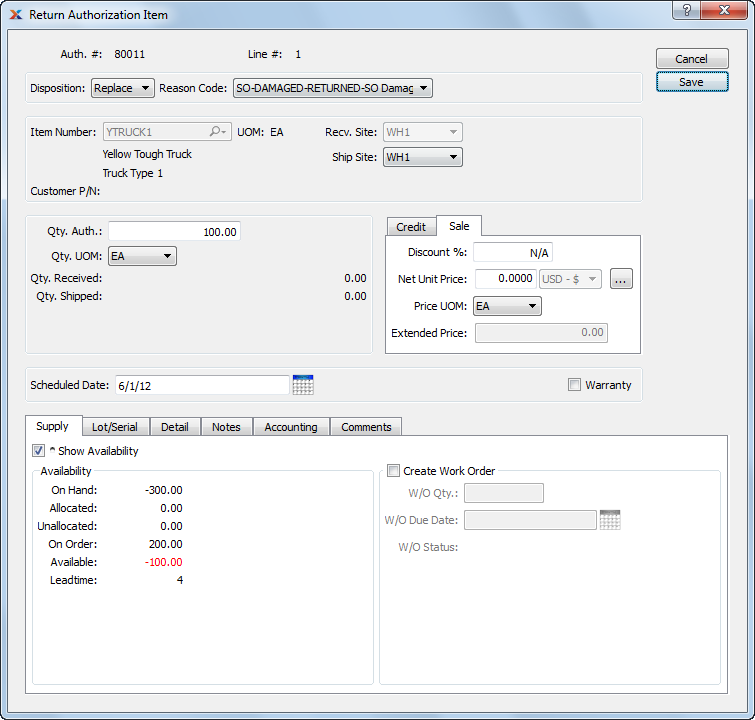
The scheduled date is the date when the Line Item quantity should be shipped. The user who enters the Line Item is responsible for determining the scheduled date. After entering the scheduled date, hit the TAB key on your keyboard to display values in the remaining display only fields.
Select if the Line Item is a warranty Item. If selected, the Cost of Warranty Account will be used when shipping the Line Item, instead of the Cost of Sales Account. It will also be used when receiving warranty Items through a Return Authorization, instead of the Cost of Returns Account.
When entering Return Authorizations you have the ability to view current availability for Line Items. You may also create replenishment Orders if they are needed.
Select if you want to display Item availability information.
If showing Item availability, the following information will be shown:
Displays the current available Quantity on Hand (QOH) value.
Displays the quantity allocated to current Sales Orders and/or Work Orders in the system. An Item is considered allocated to a Sales Order if a Sales Order Line Item exists for the Item—and that Line Item has not yet been issued to Shipping. An Item is considered allocated to a Work Order if the Item is a material requirement—and the material has not yet been issued to the Work Order. Once the current Line Item is saved, the "Allocated" value will increase by the quantity ordered.
Displays the Quantity on Hand remaining after allocations have been accounted for, as in: QOH - Allocated Qty. = Unallocated Qty.
If the Line Item is a manufactured Item, the quantity ordered by current Work Orders will be displayed. If the Line Item is a purchased Item, the quantity ordered by current Purchase Orders will be displayed.
Displays the available quantity. Available quantity is determined using the following formula: Unallocated Qty. + On Order Qty. = Available Qty.
Displays the Item Site Lead Time for the specified Line Item.
The "Show Availability" feature can be turned on or off by default at the system level. If the feature is turned on, the Availability totals will display only after a Scheduled Date has been entered for the Line Item.
If the Line Item is a manufactured Item, select this option to automatically create a Work Order for the specified quantity. For make-to-order manufactured Items, this option will be selected automatically. A Work Order will be created to meet the Return Authorization demand once you save the Line Item to the Order. An Item is designated as make-to-order if the "Create W/Os to meet Sales Demand" flag on the Item Site master is selected. A Work Order created automatically from a Return Authorization Line Item will assume the same Order Number as the new Sales Order the Return Authorization Line Item is associated with—even if that Order Number has already been used by a previous Work Order.
The quantity ordered by the Line Item will display here.
By default, the scheduled date of the Line Item will display here.
Displays the current status of the Work Order.
For Lot/Serial Items, you have the option to authorize only specific Lot/Serial quantities. The "Lot/Serial" tab will only be enabled for Lot/Serial Items. To authorize specific Lot/Serial quantities, select the "Lot/Serial" tab. The following screen will appear:
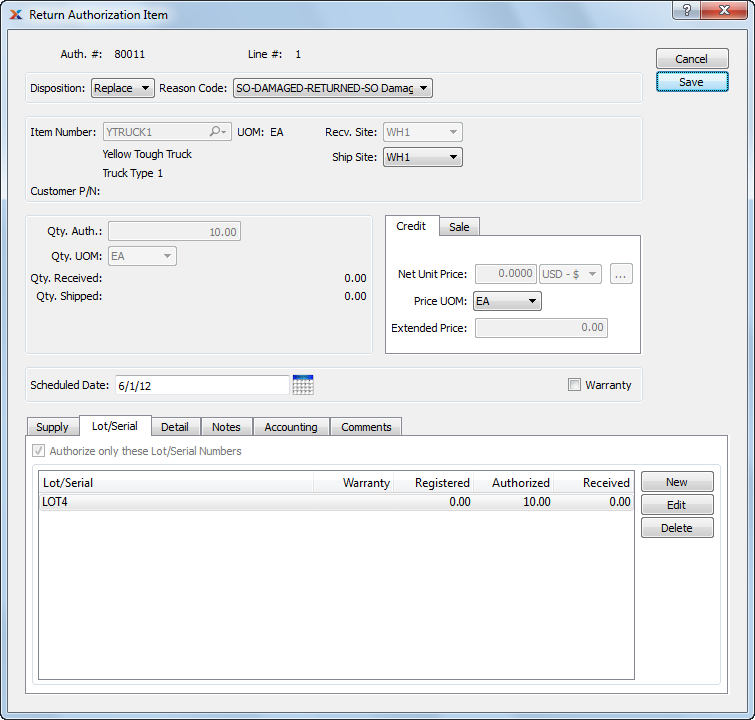
When authorizing specific Lot/Serial quantities, you are presented with the following options:
Displays any Lot/Serial quantities specifically authorized for the Return Authorization.
Select to enable the Lot/Serial selection process. When this option is selected, you will be able to select specific Lot/Serial quantities for authorization.
To view Costs or adjust Tax information for a Return Authorization Line Item, select the "Detail" tab at the bottom of the screen, as shown below:
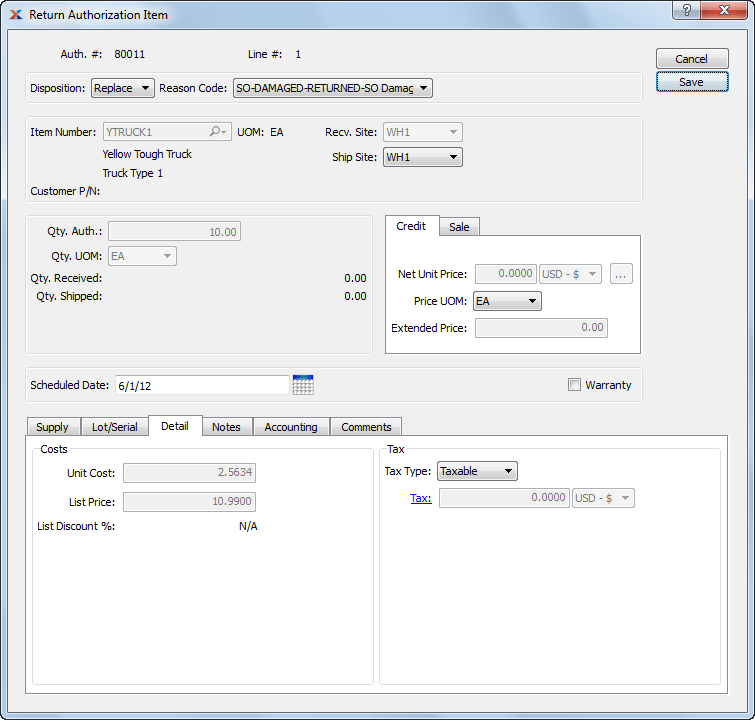
When viewing Costs or adjusting Tax information for a Return Authorization Line Item, you are presented with the following options:
Displays the Standard Cost per unit based on the Inventory Unit of Measure.
Displays the sales List Price per unit.
Displays the percentage discount off the List Price. Indicates the difference between the List Price for an Item and the Net Unit Price as a percentage. This is the margin between the Net Unit Price and the List Price.
The following Tax options are available, should you need to override the Tax Selection settings for the Line Item:
Specify the Tax Type for the Line Item. If the Item master does not have a Tax Type for the Return Authorization's Tax Authority, then no Tax will be charged.
Displays the amount of Tax to be charged for the Line Item quantity. To get a detailed view of the Tax calculation, click on the Tax link using your mouse.
To enter Notes related to a Return Authorization Line Item, select the "Notes" tab at the bottom of the screen, as shown below:
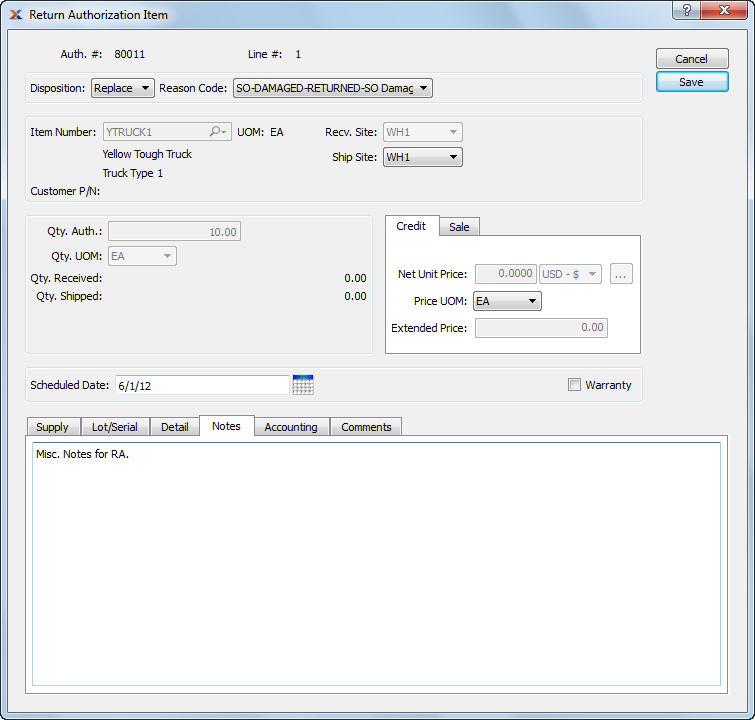
When adding Notes related to a Return Authorization Line Item, you are presented with the following options:
This is a scrolling text field with word-wrapping for entering general Notes related to the Return Authorization Line Item.
If a Return Authorization Item is marked to create a Work Order, the Production Notes for the created Work Order will contain the Sales Order Number, the Customer Name, and any additional Sales Order Line Item Notes.
To define an alternate Cost of Sales Account for a Return Authorization Line Item, select the "Accounting" tab at the bottom of the screen, as shown below:
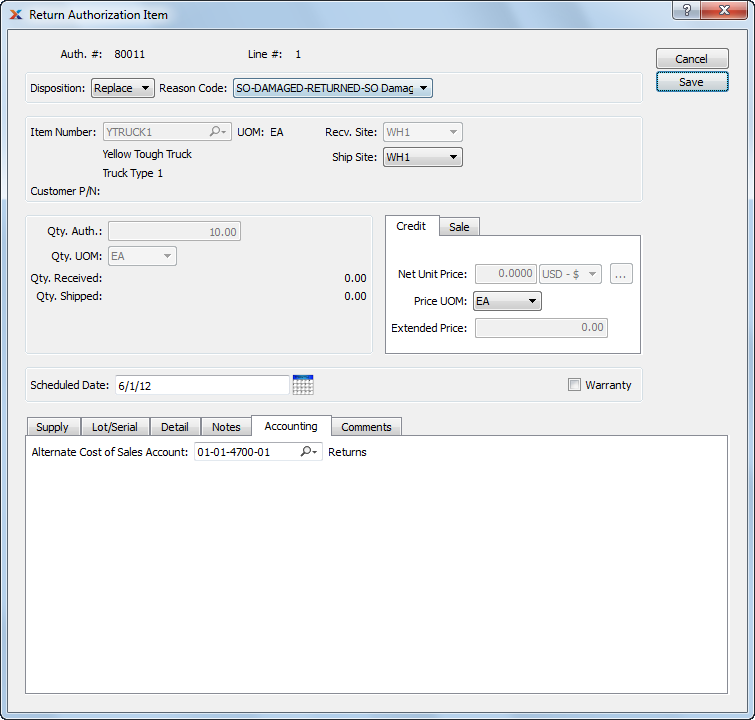
When defining an alternate Cost of Sales Account for a Return Authorization Line Item, you are presented with the following options:
Specify an alternate Account to be used for the Cost of Sales. The Account you specify will be used instead of the typical Account pre-defined in the Sales Account Assignments.
To add Comments to a Return Authorization Line Item, select the "Comments" tab. The following screen will appear:

When adding or reviewing Comments, you are presented with the following options:
Select to display all Comments in the list in an expanded view which includes the entire text of each Comment. To edit a Comment, simply select the "Edit" link next to the Comment. That link will not be shown for Changelog Comments, which can't be edited. If the "Verbose Text" option is not selected, the Comment list will display only header level information for each Comment.
Display lists Comments related to the record.
The following buttons are available:
Opens screen for creating a new Comment.
Highlight a Comment and then select this button to reach a read-only view of the "Edit" screen.
Enables you to edit highlighted Comments—as long as the Comments are not "ChangeLog" Comments. ChangeLog Comments are system-generated and may not be edited. The edit screen is the same as that for creating a new Comment—except that when editing, the fields will contain Comment information. Double-clicking on a Comment will also bring you to the editing screen.
To enter a new Comment, select the NEW button. The following screen will appear:

Select a Comment Type from the drop-down list to classify the Comment. This is a required step. Comment Types may be system-defined (i.e., "ChangeLog" and "General") or user-defined, as described in Section 13.2.2, “Comment Types”. Once you have specified a Comment Type, begin typing your Comment in the main text area. The text area features word-wrapping and scroll-bar support for longer Comments.
The following buttons are unique to this screen:
Select to show the complete list (i.e., "thread") of Comments associated with the record. To hide the list, simply select the SHOW MORE button again. The Comment thread will show the most recent Comment first.
To authorize specific Lot/Serial quantities and simplify the process for receiving Lot/Serial controlled Items on a Return Authorization, select the NEW button. The following screen will appear:
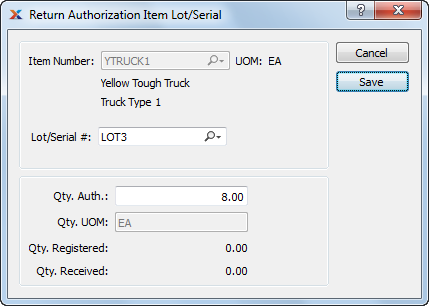
When authorizing specific Lot/Serial quantities, you are presented with the following options:
Displays the Item Number specified for the Return Authorization Item. The Inventory Unit of Measure and Item description will automatically appear.
Inventory Unit of Measure.
Select a pre-existing Lot/Serial Number for the Item. Or create a new Lot/Serial Number manually.
Enter the quantity of the specified Lot/Serial quantity you want to authorize.
The quantity authorized is based on the quantity Unit of Measure.
Displays the Unit of Measure for the authorized quantity.
Displays the Lot/Serial quantity already registered. To learn more about Lot/Serial registration, see Section 7.1, “Lot/Serial Registration”.
Displays the quantity received against the Return Authorization Line Item to date, if any.